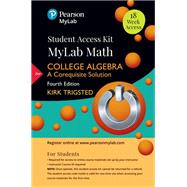NOTE: Before purchasing, check with your instructor to ensure you select the correct ISBN. Several versions of the MyLab™and Mastering™ platforms exist for each title, and registrations are not transferable. To register for and use MyLab or Mastering, you may also need a Course ID, which your instructor will provide.
Used books, rentals, and purchases made outside of Pearson
If purchasing or renting from companies other than Pearson, the access codes for the MyLab platform may not be included, may be incorrect, or may be previously redeemed. Check with the seller before completing your purchase.
For courses in College Algebra with need for extensive prerequisite support, and institutions that are looking for a corequisite solution.
Completely clickable eTexts–with a consistent author voice throughout
As a corequisite course teacher, Kirk Trigsted knows that students increasingly are being asked to commit more time and effort to their mathematics coursework. For College Algebra: A Corequisite Solution, 4th Edition , Kirk thoughtfully selected the review topics needed down to the section level, and wrote worksheets and videos that will enable students to review quickly before moving onto more difficult coursework.
The result is an online learning environment that is a seamless mix of exposition, videos, interactive animations, tutorials, and assessment–designed for the way students think and behave online. Every title in the Trigsted Precalculus series is created from the ground up within MyLab Math; all multimedia elements, exercises, feedback, and content are written by the author himself, ensuring a consistent, reassuring author presence throughout.
Personalize learning with Trigsted's College Algebra: A Corequisite Solution–built in MyLab Math
By combining trusted author content with digital tools and a flexible platform, MyLab Math personalizes the learning experience and improves results for each student.
013523624X / 9780135236246 MyLab Math for Trigsted College Algebra: A Corequisite Solution plus Guided Notebook, 4e
Package consists of:
- 0135232406 / 9780135232408 College Algebra: A Corequisite Solution - Access Kit
- 0135234026 / 9780135234020 Guided Notebook for College Algebra: A Corequisite Solution









